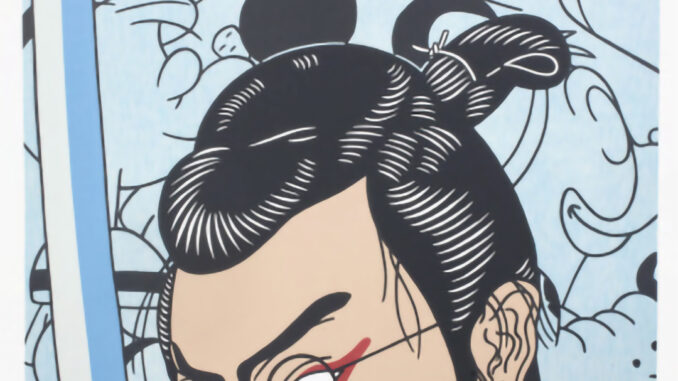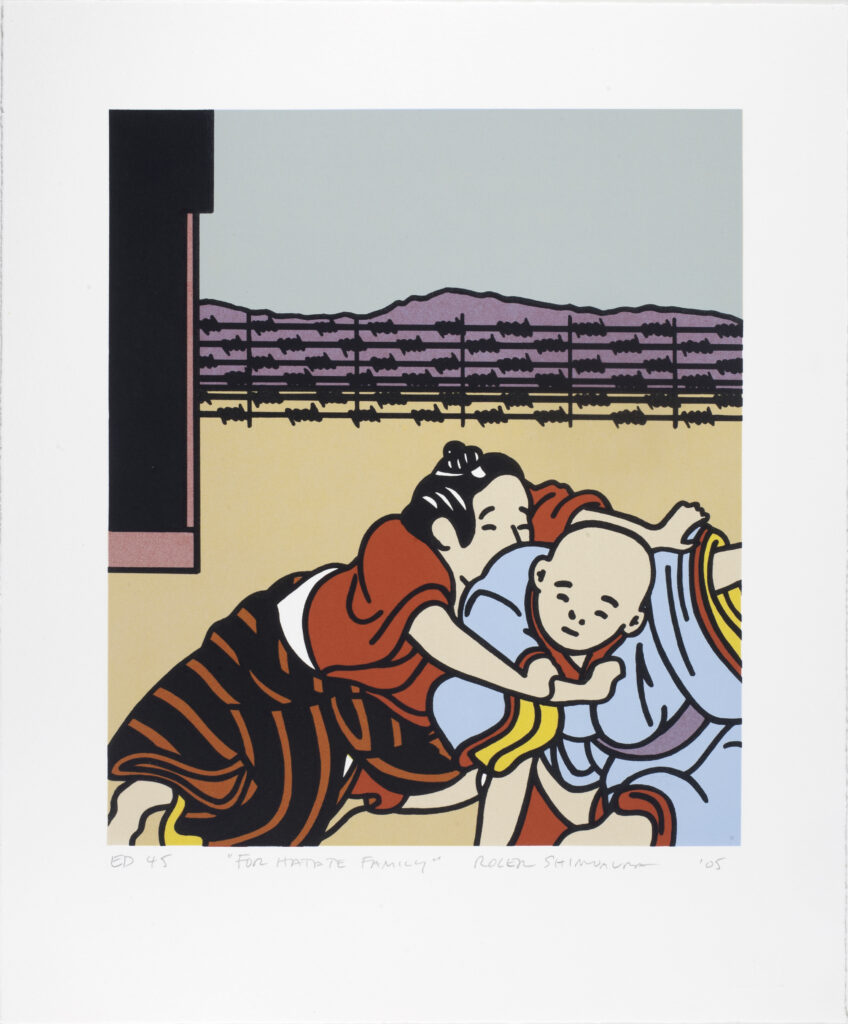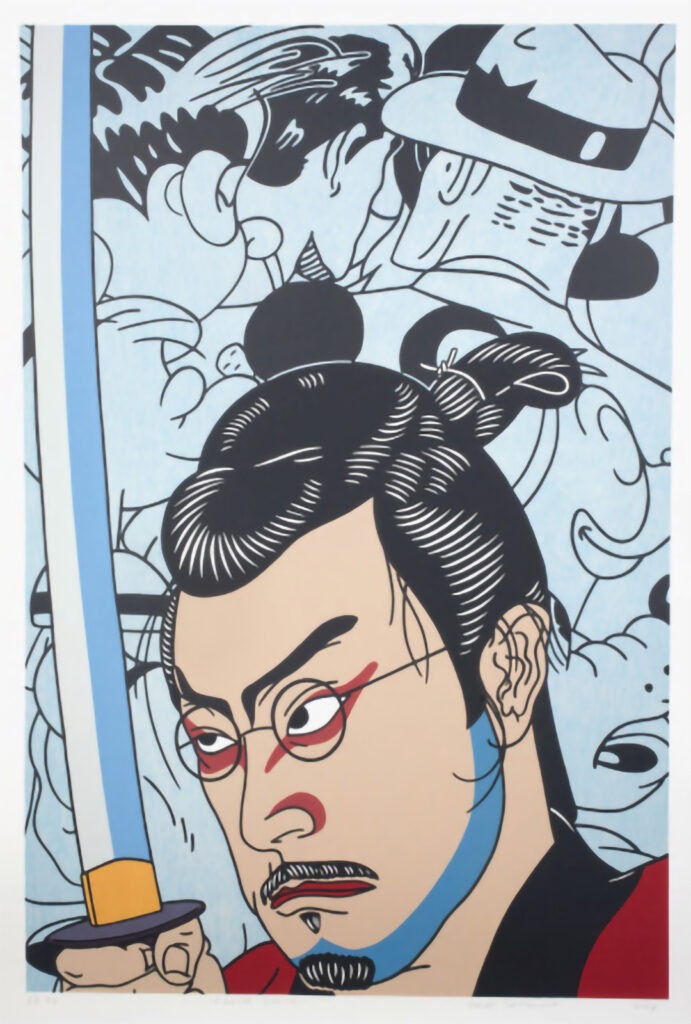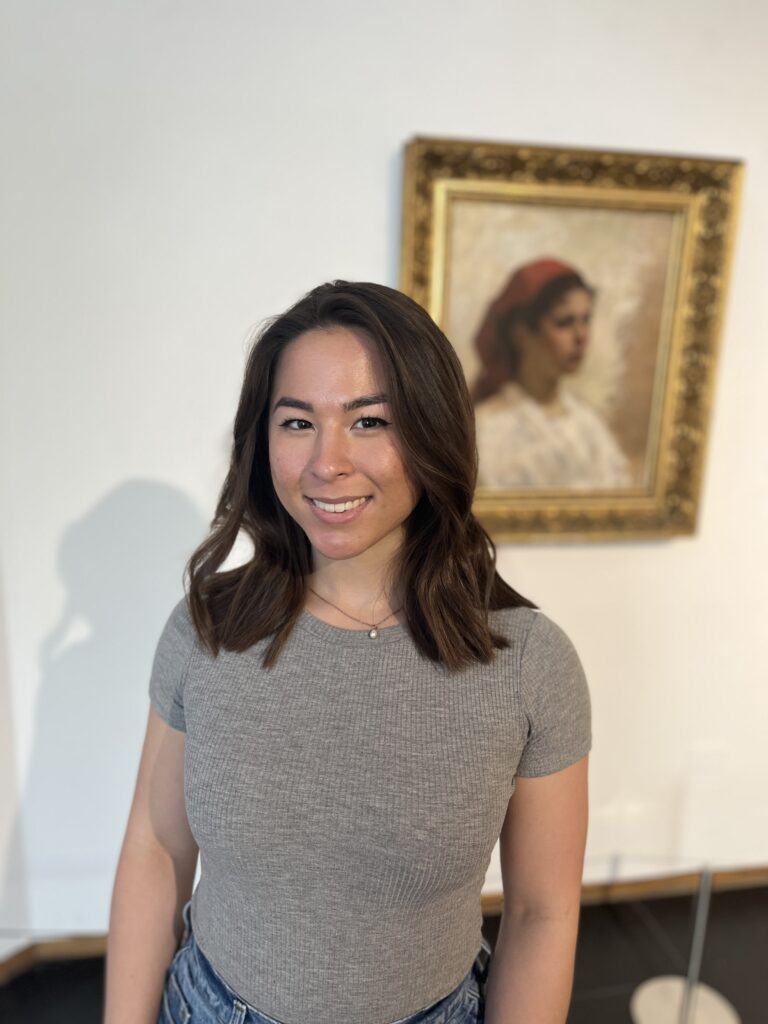
By Amelia (Millie) West
This Asian American and Pacific Islander Heritage Month, the Richard and Carole Cocks Art Museum (RCCAM) is highlighting works in the collection by artist Roger Shimomura.
Roger Shimomura is a Japanese American artist best known for his use of color lithography and American Pop art to visualize the treatment of Asian immigrants and Asian Americans in the United States. He was born in Seattle Washington in 1939 to his parents Eddy Kazuo and Ayo Shimomura who immigrated to the United States in the early 1900s. After the attack on Pearl Harbor, signing of Executive Order 9066, and the beginning of Japanese incarceration during World War II, his family was relocated to the Japanese internment camp, Camp Minidoka, in Idaho. Shimomura recounts in an interview with NPR’s Marcie Sillman that his family never talked about the experience, but the impact it left on him and hundreds of thousands of other Japanese-Americans, was the trauma of being behind barbed wire, and their treatment as “less” than other American citizens.
He informs us through his work of how blame for Japanese offenses onto Japanese American citizens stemmed from majority America’s difficulty to accept that someone who didn’t look like them could be born a US citizen. This belief was first perpetuated by General DeWitt, Commander of the Western Defense, in 1942, when he claimed that “a Jap is a Jap.” Since the illegal internment of Japanese Americans during World War II, Congress has passed a law that granted reparations to the wrongfully interned and legislation stating that the government’s actions had been based on racial prejudice, war hysteria and a failure of political leadership. Despite these reparations, prejudice still exists today in both subliminal and blatant ways.
In our collection, we have three prints made by Roger Shimomura: For Hatate Family, For Tokio Ueyama, and Kansas Samurai.

For Hatate Family (American, 2005)
Color Lithograph
Art Museum Purchase
2011.31.6
For Hatate Family is one of the prints included in Shimomura’s Mistaken Identities series from 2005. The This series was inspired by notable photographs and paintings made and taken during internment camps. This particular piece is inspired by the painting Children Playing which belonged to the Hatate family.

For Tokio Ueyama (American, 2005)
Color Lithograph
Art Museum Purchase
2011.31.3
Another print from Mistaken Identities, For Tokio Ueyama, takes inspiration from the photo Girl with ID Tag photographed by Dorothea Lange. Both of these artworks place traditionally Japanese figures wearing clothing such as a kimono, geta, and headdress, inside Japanese American internment camps. This brings attention to America’s inability during World War II to differentiate between Japanese Americans and Japanese enemies.
He speaks on how the modernity of this issue persists in an interview with Rebecca Sutton from the National Endowment for the Arts, stating:
“When I got to Kansas for my first teaching job, all of a sudden, I was in foreign country. All of a sudden, I was Japanese again and people were asking me, ‘How did you come to speaking the language so well? Where are you from?’ All of those clichéd responses that any Asian American would tell you happens to them anyplace off of the West Coast.”

Kansas Samurai (American, 2004)
Color Lithograph
Art Museum Purchase
2011.30
Kansas Samurai is an artwork created by Shimomura to represent the rejection experienced by those who aren’t members of the majority culture. In the piece, American pop culture icons- such as Donald Duck, Dick Tracy, and Goofy- are depicted turning away from the samurai in the foreground. Shimomura began working in the style of American Pop-art and later infused it with traditional Japanese woodblock. Although foreign to the style of Japanese woodblock, he found a striking similarity between the two and how they both visually “popped.” When speaking on the politics of his art, Shimomura said that his goal is to address these topics, but he does not expect to change people’s opinions. Instead, his hope was to “plant something in their mind to take with them, [then] you’ve really done something.”
Shimomura’s art is an important representation of Asian American identity and challenges viewers to reflect on how we both contribute to and fight against these negative social perceptions.
Information was compiled from research of Art Museum object files and additional sources including Wiki and the Lawrence Lithography Workshop.

ABOUT THE AUTHOR
My name is Millie West and I’m a rising Sophomore Art and Architecture History student at Miami University. During the Fall & Spring Semesters of this year, I interned at the museum first in the Fall as a Marketing & Communications Intern working with Sherri Krazl and most recently I worked alongside Collections Manager/Registrar Laura Stewart for a Collections internship.
